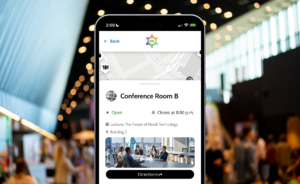Integrating digital maps into your existing systems is easier than you think. Whether your retail space has an established app or you’re new to the latest navigation technology, this guide outlines how to seamlessly and efficiently integrate indoor mapping with existing navigation systems.
Step 1: Find the Right System for Your Business
Large retail centers and commercial areas like airports need an indoor mapping solution that can easily integrate with existing systems to prevent confusion and frustration among customers. As you build the right technology stack for your mall or retail space, keep these factors in mind when searching for indoor mapping solutions.
Ensure Scalability and Analytics
There is value in integrating indoor digital maps with pre-existing systems. The indoor mapping solution should be beneficial for customers and also aid in improving profits and monetizing traffic for malls and retail space developers. Indoor digital mapping systems like MapVX use APIs and SDKs for integrating mapping data along with employing cloud-based solutions for real-time updates and scalability.
Pricing
Finding a customizable digital mapping solution that fits your business is important. MapVX works with each company individually to assess each business’s specific needs and find a budget that works best for you. Book a free MapVX demo today to learn more about plans and pricing.
Step 2: Assess the Environment and User Needs
A thorough survey of your space will be conducted to assess and map the facilities. This includes gathering all floor plans, entrances and exits, obstacles, elevators, and staffing areas.
In addition to considering your space, also consider your customers’ needs expectations. What feedback are guests providing you about your current navigational systems? How can you create a seamless experience for positive reviews? Determine essential features you want your digital indoor mapping solution to highlight, like store locators, restroom directions, and emergency exits.
Step 3: Develop the Integration Workflow and User Interactive Features
Your workflow will include your server host, indoor mapping solution, other WiFi-based IPS and Bluetooth beacon data collection systems, customer loyalty reward apps, and retailer-specific data. Your mapping developer team will start by converting physical floor plans into digital 3D maps of your space to create an indoor map unique to your retail space.
Once the indoor digital map is ready to integrate with external systems, developers will link the indoor map with external navigation apps and tools. When integrating the new indoor digital map into your existing systems, these Key Features will make the navigational tools customer-friendly:
Highlight Key Spaces
The first thing guests should notice when looking at an indoor map is their current location, exits, and bathrooms. A customizable indoor digital mapping solution can highlight other high-traffic areas like food courts, department stores, and event areas.
Interactive Maps
Allow users to interact with the indoor map for zooming, panning, and selecting points of interest on monitors or shopping mall navigational kiosks provided throughout the area.
Search Tool
The search functionality for guests to locate specific destinations is important so people don’t have to sift through a long directory list to find the store or item they are looking for.
Turn-by-Turn Navigation
Large retail spaces like airports or malls benefit from providing turn-by-turn directions for guests. Visual and voice guidance will streamline customers’ in-person retail experience, instead of them having to figure out directions themselves.
Multi-Language Support
Malls and retail centers in airports are visited by people from all around the world. Ensure the indoor mapping system supports multiple languages for international users.
Accessibility Options
People with disabilities also visit malls and shopping areas, so providing accessible navigational options is vital. Turn-by-turn navigation should offer accessible routes with visual and voice guidance.
Take Maps On-the-Go
Offer a custom mobile app that allows people to get real-time indoor navigation. QR codes on kiosks or monitors are perfect for encouraging people to download your retail center’s app. Offer personalized recommendations and navigational tools to keep customers using the app. Your business will also have access to the analytics from the indoor mapping system that you can leverage for enhanced operations.
Real-Time Updates
Using analytics, you’ll be able to notate the stores and items that people are searching for the most, when and where hot spots are, and the spaces that aren’t seeing traffic. Push real-time notifications on deals, events, or store changes to customers using this information.
Step 4: Test and Optimize
Before you launch or relaunch your mall or retail area’s navigational systems, the tools need to be tested to ensure functionality and user readiness.
Do a pilot test and run the system in a controlled environment to gather feedback from customers and shop owners. Retail spaces are frequented by people from all walks of life so this test group needs to be diverse with people from multiple demographics.
As the navigational software and hardware tools are being tested, also look at the performance metrics. Is the search tool working accurately? How long are system load and response times? By tracking these metrics and user engagement, you’ll be able to better ensure success rates.
Step 5: Deploy and Maintain
When your team and retail space are ready to deploy the indoor mapping systems, ensure your onsite staff are trained to assist users as you’ll likely get the most feedback when you first launch the product. Indoor digital mapping solution MapVX has a dedicated Customer Success Team for personalized support and custom integrations as needed, to ensure that your staff is set up for success.
Continuous improvements and maintenance are vital to ensuring user navigational success. Regularly update maps to reflect layout changes and incorporate user feedback to refine digital features. Schedule regular updates to maintain accuracy and monitor hardware and software performance.
Best Practices for Integration
As you and your development team continue the integration process and beyond, there are several factors to keep in mind for a seamless user experience:
User-Centric Design
Prioritize simplicity and usability. Every demographic of people should find navigational systems and tools easy to use.
Data Security
Protect user data and comply with privacy regulations. Utilize malware protection systems and opt for secure WiFi networks.
Scalability
Choose technologies that can grow with the environment’s needs. As the mall and retail space change, so does technology. Scalable and adaptable indoor mapping solutions can update the system as needed.
Conclusion: Integrating Digital Maps with Existing Systems
Integrating digital maps with existing navigational systems can significantly enhance customer experiences in large, complex environments like shopping malls, airports, and other retail spaces. By learning from this guide and leveraging the right technology for your business, you can create a seamless navigation solution that meets operational and customer needs. Ensure the long-term success of your business by prioritizing ongoing system updates and user feedback.






